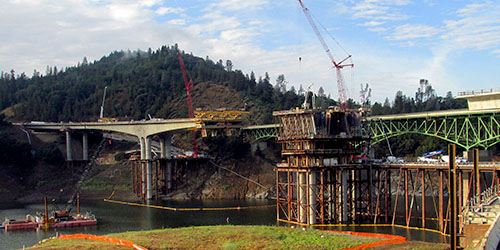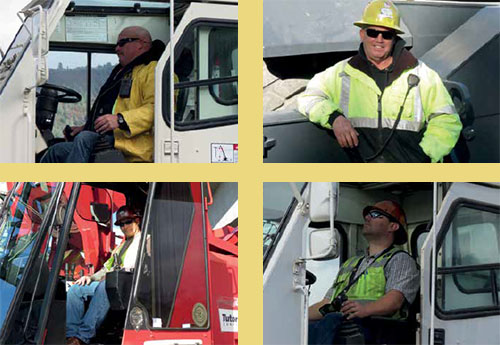CCO-certified operators bring their expertise to bear on I-5 bridge construction.
September 2017—A team of seasoned CCO-certified crane operators worked for more than five years on one of California’s largest public works projects since the completion of the Oakland Bay Bridge. The Antlers Bridge reconstruction project—located along Interstate 5 in upstate California, near Lakehead—is owned by the California Department of Transportation (CALTRANS). It was managed by general contractor Tutor-Perini, which is also building the first legs of the next major CALTRANS signature initiative, the California High Speed Rail project.
Over the life of the Antlers Bridge project, four three-time (“3-Star”) CCO recertificants plus one relatively recently CCO-certified mobile crane operator—all members of IUOE Local 3—made their mark on this intricate, high-visibility effort to replace the original steel span built in 1941. The new structure is a five-span cast-in-place, segmental, post- tensioned, box girder bridge and is the largest structure of its type in California north of the San Francisco Bay area. The new 1,942-foot long bridge required approximately 67,000 cubic yards of concrete, including 4,000 cubic yards in the pier tables alone, which extend 60-80 feet below the mud line to support the structure.

At almost 2,000 feet long, the new Antlers Bridge required 67,000 cubic yards of concrete and is the largest structure of its type in California north of the Bay Area.
Projects of this scale and duration are relatively rare, so the experience brought by the CCO-certified crane operators was invaluable in terms of both safety and efficiency. Senior operator Chris Dickson was on the Antlers Bridge project almost since the beginning; he has nearly 30 years of crane operating experience, having logged 15 years with Bragg Crane before becoming CCO-certified more than 15 years ago. Chris sees the computers and electronics built into today’s cranes as being a key challenge to safe operations. “I strongly believe that operators should be skillful enough to operate a crane without modern operator aids,” he says. He found the Antlers Bridge project to be particularly challenging due to the need to “constantly move and set up cranes in limited space and extreme terrain conditions.”

CCO-certified crane operators (clockwise from top left) Alvin McGavin, Chris Dickson, Pat Billington, and Ben Scott, who between them have notched up more than a dozen five-year certification cycles, brought their knowledge and expertise to valuable effect on the project.
“The team’s experience was particularly important considering the safety issues associated with demolition,” according to 3-Star CCO operator Alvin McGavin. “We had lots of people on the ground and a ton of work required to be performed ‘in the blind.’” Ben Scott, another 3-Star CCO operator, echoed the importance of having the non-operator members of the lift team be CCO-certified as riggers and signalpersons. “People on the job need to know how to do their tasks the right way, particularly when giving verbal commands and especially when working in the blind.”
Relative newcomer Pat Billington was on the Antlers Bridge project for three and a half years, and he also echoed the importance of having everyone on the team be CCO-certified. “It’s vitally important for an operator to trust people, so having everyone on the same page greatly enhances jobsite safety.”